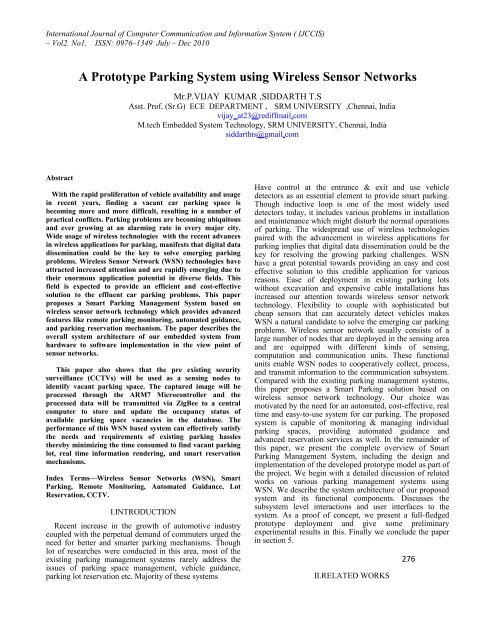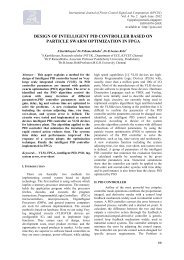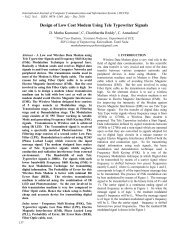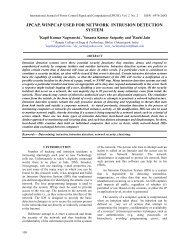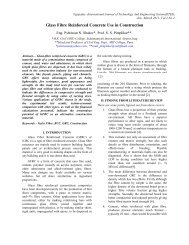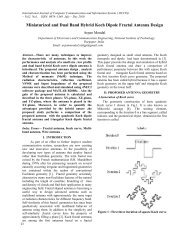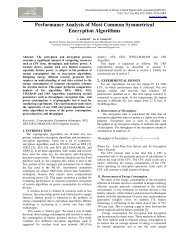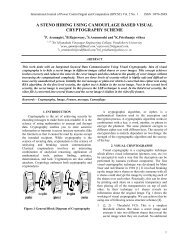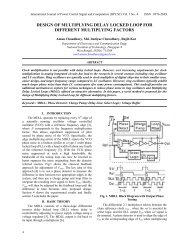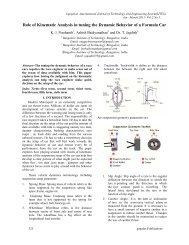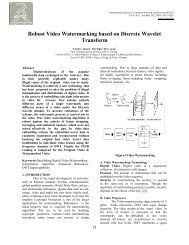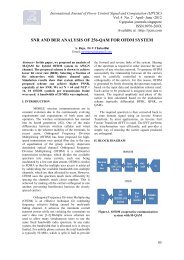A Prototype Parking System using Wireless Sensor Networks
A Prototype Parking System using Wireless Sensor Networks
A Prototype Parking System using Wireless Sensor Networks
You also want an ePaper? Increase the reach of your titles
YUMPU automatically turns print PDFs into web optimized ePapers that Google loves.
International Journal of Computer Communication and Information <strong>System</strong> ( IJCCIS)– Vol2. No1. ISSN: 0976–1349 July – Dec 2010A <strong>Prototype</strong> <strong>Parking</strong> <strong>System</strong> <strong>using</strong> <strong>Wireless</strong> <strong>Sensor</strong> <strong>Networks</strong>Mr.P.VIJAY KUMAR ,SIDDARTH T.SAsst. Prof. (Sr.G) ECE DEPARTMENT , SRM UNIVERSITY ,Chennai, Indiavijay_at23@rediffmail.comM.tech Embedded <strong>System</strong> Technology, SRM UNIVERSITY, Chennai, Indiasiddarthts@gmail.comAbstractWith the rapid proliferation of vehicle availability and usagein recent years, finding a vacant car parking space isbecoming more and more difficult, resulting in a number ofpractical conflicts. <strong>Parking</strong> problems are becoming ubiquitousand ever growing at an alarming rate in every major city.Wide usage of wireless technologies with the recent advancesin wireless applications for parking, manifests that digital datadissemination could be the key to solve emerging parkingproblems. <strong>Wireless</strong> <strong>Sensor</strong> Network (WSN) technologies haveattracted increased attention and are rapidly emerging due totheir enormous application potential in diverse fields. Thisfield is expected to provide an efficient and cost-effectivesolution to the effluent car parking problems. This paperproposes a Smart <strong>Parking</strong> Management <strong>System</strong> based onwireless sensor network technology which provides advancedfeatures like remote parking monitoring, automated guidance,and parking reservation mechanism. The paper describes theoverall system architecture of our embedded system fromhardware to software implementation in the view point ofsensor networks.This paper also shows that the pre existing securitysurveillance (CCTVs) will be used as a sensing nodes toidentify vacant parking space. The captured image will beprocessed through the ARM7 Microcontroller and theprocessed data will be transmitted via ZigBee to a centralcomputer to store and update the occupancy status ofavailable parking space vacancies in the database. Theperformance of this WSN based system can effectively satisfythe needs and requirements of existing parking hasslesthereby minimizing the time consumed to find vacant parkinglot, real time information rendering, and smart reservationmechanisms.Index Terms—<strong>Wireless</strong> <strong>Sensor</strong> <strong>Networks</strong> (WSN), Smart<strong>Parking</strong>, Remote Monitoring, Automated Guidance, LotReservation, CCTV.I.INTRODUCTIONRecent increase in the growth of automotive industrycoupled with the perpetual demand of commuters urged theneed for better and smarter parking mechanisms. Thoughlot of researches were conducted in this area, most of theexisting parking management systems rarely address theissues of parking space management, vehicle guidance,parking lot reservation etc. Majority of these systemsHave control at the entrance & exit and use vehicledetectors as an essential element to provide smart parking.Though inductive loop is one of the most widely useddetectors today, it includes various problems in installationand maintenance which might disturb the normal operationsof parking. The widespread use of wireless technologiespaired with the advancement in wireless applications forparking implies that digital data dissemination could be thekey for resolving the growing parking challenges. WSNhave a great potential towards providing an easy and costeffective solution to this credible application for variousreasons. Ease of deployment in existing parking lotswithout excavation and expensive cable installations hasincreased our attention towards wireless sensor networktechnology. Flexibility to couple with sophisticated butcheap sensors that can accurately detect vehicles makesWSN a natural candidate to solve the emerging car parkingproblems. <strong>Wireless</strong> sensor network usually consists of alarge number of nodes that are deployed in the sensing areaand are equipped with different kinds of sensing,computation and communication units. These functionalunits enable WSN nodes to cooperatively collect, process,and transmit information to the communication subsystem.Compared with the existing parking management systems,this paper proposes a Smart <strong>Parking</strong> solution based onwireless sensor network technology. Our choice wasmotivated by the need for an automated, cost-effective, realtime and easy-to-use system for car parking. The proposedsystem is capable of monitoring & managing individualparking spaces, providing automated guidance andadvanced reservation services as well. In the remainder ofthis paper, we present the complete overview of Smart<strong>Parking</strong> Management <strong>System</strong>, including the design andimplementation of the developed prototype model as part ofthe project. We begin with a detailed discussion of relatedworks on various parking management systems <strong>using</strong>WSN. We describe the system architecture of our proposedsystem and its functional components. Discusses thesubsystem level interactions and user interfaces to thesystem. As a proof of concept, we present a full-fledgedprototype deployment and give some preliminaryexperimental results in this. Finally we conclude the paperin section 5.II.RELATED WORKS276
International Journal of Computer Communication and Information <strong>System</strong> ( IJCCIS)– Vol2. No1. ISSN: 0976–1349 July – Dec 2010In this section we review the literature on existing andproposed parking lot applications based on WSN. Lee,Yoon and Ghosh proposed a hybrid approach[1] For an intelligent parking system <strong>using</strong> a combinationof ultrasonic and magnetic sensors. They demonstratedpromising results through various real world experimentsand showed that these hybrid solutions are more practicaland accurate. Though the main goal was to count thenumber of vehicles on each floor and provide a cheap andaccurate solution, the scope of their work restricts itself tovehicle detection <strong>using</strong> WSN than providing a smarterparking management solution. D-<strong>System</strong>s Project[2] Presented various issues for a reliable WSN system<strong>using</strong> magnetic sensors. As part of this project animplementation of a car-park management system <strong>using</strong> atiered architecture is detailed <strong>using</strong> magnetic sensor boards.of dynamic & robust routing, delayed retransmissions, etc.Jatuporn et al.[3], proposed optical WSN as a vehicle counting system insmart parking garages. Their proposed solution is to addanother optical sensor head to the wireless sensor node.Two sensor heads were used to classify the objects ofdifferent sizes thereby distinguishing and identifyingdifferent vehicles.Fig 2: TransmitterIII. OUR SYSTEM ARCHITECTUREFig. 3: ReceiverIn this section, we describe the design of Smart <strong>Parking</strong>management system which consists of WSN,communication subsystem, <strong>Parking</strong> Management,Automated Guidance, Entrance Display and ClientReservation subsystems. At a glance, the system shall beable to graphically display real time information related tothe availability of parking lots to the users and would alsoenable users to reserve parking lot from remote locations.The system will also be capable of guiding users toefficiently locate vacant parking spaces so as to park theircars quickly and safely. Figure 1 details the systemarchitecture of our system. The overall architecture isdivided into six major subsystems as mentioned. Thefunctions of each subsystem are as follows.A.WSN Subsystem277Fig. 1: <strong>System</strong> ArchitectureWSN subsystem mainly deals with monitoring of parkingstatus. This subsystem detects the status of parking spacewith hybrid sensing techniques and transmits statusinformation through RF. It also receives commands fromparking management subsystem to carry out variousprocedures. The subsystem internally consists of four major
International Journal of Computer Communication and Information <strong>System</strong> ( IJCCIS)– Vol2. No1. ISSN: 0976–1349 July – Dec 2010modules which include sensing, routing, dissemination andstatus modules. <strong>System</strong> Architecture of our embeddedsystem.B.Communcation SubsystemThis subsystem collects the parking status report fromWSN subsystem and delivers them to the parkingmanagement subsystem. It acts as a gateway betweenwireless sensor network and external networks. Thissubsystem also forwards the information regarding thechange in parking status received from managementsubsystem to the guidance subsystem through Wi-Fi/Bluetooth/RF interfaces.C.<strong>Parking</strong> Management SubsystemThis subsystem acts as the heart of entire our system.Whenever communication subsystem sends data to theparking management subsystem, the gateway transceivermodule associated with the subsystem receives the data,processes it and forwards to the database module and viceversa. The database module stores the event based sensordata and the health information of the sensor nodes. Thesensor & guiding node information from the database willbe collected by the parking guidance module and displaysthe corresponding information on the parking lot GUI. Italso takes the health information from sensor healthmonitoring module & displays on GUI. <strong>Parking</strong> entrancedisplay module existing on this subsystem getsconsolidated status information from the database and thenprocesses the information to be sent to the parking entrancedisplay. Whenever the client reserves a parking lot, thereservation message will be forwarded to parkingreservation module running on the management subsystem.It will further retrieve data from the sensor database andbased on the availability of parking lots will forward anacknowledgment to the client.D.Automated Guidance SubsystemGuiding nodes divide their managing areas into severalsections according to the turn offs of the parking layout.This subsystem helps vehicles to find idle parking spaceswithin less time. It consists of 2 modules which are asfollows:availability of the parking lots in all the directions(Left/Right/Ahead) which shown figure 7.E.Entrance Display SubsystemAs the name suggests, this subsystem is placed at theentrance of the parking. It shows the status of the parkinglots to the users before entering the parking area. Thissubsystem is divided into 2 modules as followsa) Entrance Display ApplicationWhenever there is a change in the status, the parkingentrance display module on the management subsystemprocesses the information and forwards it to the parkingentrance display subsystem. The entrance displayapplication running on this subsystem receives andprocesses the data. The processed data is then forwarded tothe parking entrance display for displaying the statusb) <strong>Parking</strong> Entrance DisplayThis module displays the parking status information to theusers received from the entrance display application. Itshows the complete status of the whole parking layout(Total lots occupied/vacant) which shown figure 8.F. Client SubsystemClient Subsystem is the one which allows the clients toremotely interact with our system. This subsystem consistsof 2 modules which mainly run on the clientele devices.They are1. Client ApplicationThis mainly runs as a background process which processesthe inputs given by the user through the parking reservationGUI and sends the information to the parking managementsubsystem.2. <strong>Parking</strong> Reservation GUIparking reservation GUI is a front-end applicationrunning on the clientele devices allowing the users to givetheir parking details (License Number + Time of parking)in order to reserve a parking lot. This information is laterprocessed by client application and sent to the parkingmanagement subsystem to allocate a parking lot which isshown in figure 6.278a) Guiding ApplicationIf there is a change in the status, the managementsubsystem processes the information and forwards it to thesink subsystem. The processed data is then forwarded bysink subsystem to the guiding application running on theguidance subsystem, which is later depicted on parkingguidance display.b) <strong>Parking</strong> Guidance DisplayThis module collects the information from the guidingapplication and displays it to the users. It shows theG. Sensing TechniqueTo detect an event we evaluate (Base light - Sn) >Threshold, where Base light is calculated through referencemotes deployed in the parking lot. This value will eliminatethe disparity in light readings due to environmentalvariations. Sn is the averaged light readings for apredefined period of time (1 second in our case). If the
International Journal of Computer Communication and Information <strong>System</strong> ( IJCCIS)– Vol2. No1. ISSN: 0976–1349 July – Dec 2010difference in readings exceed the set threshold, then weassume that the lot is occupied with a car, else, we considerthat the lot is vacant.while(1){do{temp= rx();}while(temp!='A');//printf("\b%c",temp);temp = rx();cmd_lcd(0x8e);dat_lcd(temp);temp1 = 0x39-temp;temp2 = temp1+0x30;cmd_lcd(0xCe);dat_lcd(temp2);printf("Vehicles Parked :%c\n ",temp);printf("Vacancy Slots: %c\n\n",temp2);}}6. PROTOTYPE OF PARKING LAYOUTFig 4: prototype of parking GUIFig 5: LEDFig 6: Reservation SlotFig7:ARM7-TDMIFig8: Entrance DisplayFig9: GSM DeviceIV <strong>System</strong> EvaluationOur prototype system is developed as a proof of conceptto meet the real time requirements of parking managementsystems. We have carried out preliminary experiments toevaluate the functionalities and features provided by ourprototype system. In our initial experiment we havemodelled this prototype for 4 parking lots which is shownin figure 4.1 <strong>Parking</strong> Monitoringa) Scenario 1: Total parking lots are vacant: When all theparking lots are vacant, the sensor nodes placed in theparking lots detect that there is no event generated. Theentrance display shows total vacant lots as 4 and parking lotas 0 and GUI depicts the same as shown in figure 8.b) Scenario 2: Two cars are parked: In this scenario weexperimented by parking two cars in the parking lots. Thesensor nodes detected the events and transmitted the reportmessage to the communication subsystem. Thecommunication subsystem in turn forwarded thesemessages to the management server. The managementserver processes this information and sends the status reportto the respective guiding nodes and entrance display. Theentrance display and parking lot GUI then, displayed thetotal no of vacant lots as 2.2. <strong>Parking</strong> ReservationThe user interested in reserving the parking 279 lot wouldsubmit his parking details on the client reservation GUIrunning on his mobile phone. This SMS Message isforwarded to the management server through the GSMinterface. In this case the management server finds parkinglot number 4 to be vacant and sends confirmation message,allocated SLOT parking lot number 1 and start time of parking tothe user. The management server will also send the statusinformation to the WSN subsystem which will turn on theblue LED of parking lot 4 as shown in figure 6 and theparking lot GUI updates the parking lot number 4 asreserved.3. <strong>Parking</strong> Guidance
International Journal of Computer Communication and Information <strong>System</strong> ( IJCCIS)– Vol2. No1. ISSN: 0976–1349 July – Dec 2010We depict the feature of parking guidance provided by ourprototype system in this case. The parking guiding nodesare deployed at the turn offs of the parking area these nodesdepict the availability of parking lots in three directions(left/right/ahead) which is shown in figure 5.V.CONCLUSIONIn this paper, we described the Smart management system<strong>using</strong> wireless sensor networks. Based on the requirementanalysis for existing car parking management systems, wedesigned the system architecture and its subsystem levelcomponents. We implemented a full-fledged prototypemodel as a proof of concept to realize and understand thereal time scenarios in parking management systems.Through our prototype system we demonstrated that theproposed architecture can effectively satisfy therequirements of a car park management system and webelieve that wireless sensor networks can be a promisingtechnology to solve future parking hassles.[10] Tapas, Dileep K Panjala, S V Srikanth <strong>System</strong> RequirementSpecifications for SPARK, for Establishment of National LevelUbiquitous Research Resource Centre, C-DAC Hyderabad, 2008[11] Jeffrey F. Paniati, Associate Advance <strong>Parking</strong> Management <strong>System</strong> :A Cross- Cutting Study, Taking The Stress Out Of <strong>Parking</strong>, January2007[12] Gaurav Sehgal Monash Car Park SMS Project, School Of ComputerScience And Software Engineering Monash University Research Proposal,2005[13] Tapas, Dileep K Panjala, S V Srikanth High Level Design Documentfor SPARK, for Establishment of National Level Ubiquitous ResearchResource Centre, C-DAC Hyderabad, 2008[14] http://www.amontec.com/lcd nokia 3310.shtml[15] http://www.xbow.com/Products/Product pdf files/<strong>Wireless</strong> pdf/ MTSMDA Datasheet.pdf[16] www.xbow.com/Products/Product pdf files/<strong>Wireless</strong> pdf/MICAZ Datasheet.pdf[17] www.analogicgroup.com/Pdfs/datasheets/smart modem.pdfREFERENCES[1] Sangwon Lee, Dukhee Yoon and Amitabha Ghosh, Intelligent <strong>Parking</strong>Lot Application Using <strong>Wireless</strong> <strong>Sensor</strong> <strong>Networks</strong>, Proceedings of IEEEconference, 978-1-4244-2249-4/08[2] Barton, J., J. Buckley, B. O’Flynn, S.C. O’Mathuna, J.P. Benson, T.O’Donovan, U. Roedig, and C. Sreenan, The D-<strong>System</strong>s Project –<strong>Wireless</strong> <strong>Sensor</strong> <strong>Networks</strong> for Car- Park Management, Proceedings of the65 th IEEE Vehicular Technology Conference, Dublin, Ireland, Apr 2007,pp. 170-173.[3] IrisNet: Internet-scale Resource-Intensive <strong>Sensor</strong> Network Service,http://www.intel-iris.net[4] Jatuporn Chinrungrueng, Udomporn Sunantachaikul, SatienTriamlumlerd Smart <strong>Parking</strong>: an Application of optical <strong>Wireless</strong> <strong>Sensor</strong>Network, roceedings of the 2007 International Symposium onApplications and the Internet Workshops (SAINTW’07)[5] Tang, V.W.S., Y. Zheng, and J. Cao An Intelligent Car ParkManagement <strong>System</strong> based on <strong>Wireless</strong> <strong>Sensor</strong> <strong>Networks</strong>, Proceedings ofthe 1st International Symposium on Pervasive Computing andApplications Urumchi, Xinjiang, China, Aug 2006, pp. 65?70.[6] BI Yan-Zhong, SUN Li-Min, ZHU Hong-Song, YAN Ting-Xin, LUOZheng-Jun A <strong>Parking</strong> Management <strong>System</strong> Based on <strong>Wireless</strong> <strong>Sensor</strong>Network, ACTA AUTOMATICA SINICA, November 2006, Vol. 32, No.6[7] http://www.tinyos.net[8] http://www.xbow.com[9] Michelle Crowder, C. Michael Walton Developing An Intelligent<strong>Parking</strong> <strong>System</strong> For The University Of Texas At Austin, Research ReportSwutc/03/167229-1280


